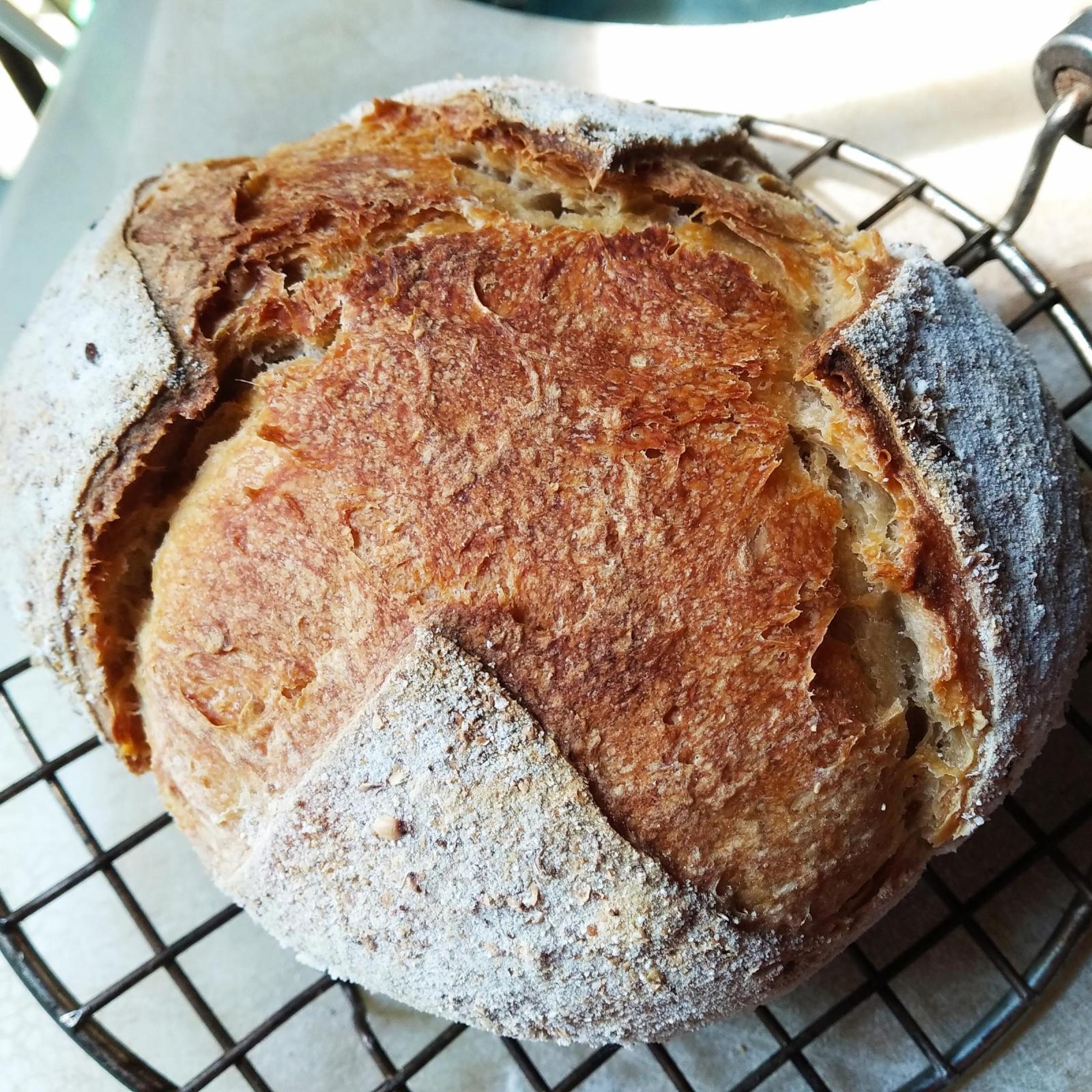Hello, I'm baking the same simple sourdough boule recipe (from Teresa Greenway's course) to get better at the steps, and figure out where I need to adapt things for my own environment (tropics, OTG with granite stone as bottom rack, India, Indian maida flour and home-milled, home-grown ww milled in a Komo fidibus). Eventually I want to move to using exclusively my own ww.
140g starter (100% hydration, whole wheat)
240 g water
400 g flour (commercial maida)
7 g salt
3 S&F over three hours in the late evening, overnight BF, reshaping and proofing for 90 minutes in the morning, after about an hour out of the fridge. OTG preheated at 250C / 482F (highest it will go) for 40 minutes, heat down to 230 C / 446F after loaf slides on to the stone, bake for 50 minutes, turning round once in between.

1) I think the oven spring is decent and the taste is delightful, but I wonder if the scoring should be deeper to prevent the cracking that happened towards the end?
2) The internal temperature of the loaf after 50 minutes was 100C / 212F. But when cut after two hours, the crumb was still a bit gummy, like this. If the temperature suggests 'done', what might be causing this? My yeasted sandwich loaves with the same flour, or even fully whole wheat are not gummy like this. Is it the sourdough texture? The hydration (66%)? Or is my OTG not really getting up to 230C / 446F at all, and should I bake at the preheating temp of 250C / 482F? But if it is not heating properly why does the internal temp register 100C / 212F? Will it help if I bake the same boule in a preheated Dutch oven instead of the granite stone?

Please help! What tweaks should I make to the whole process? Unfortunately I have to work with the ingredients I have - I can try moving to another brand of maida, but that's about it. I have seen others produce beautiful sourdough loaves locally with maida, though, so I *don't* think it's the flour. Thanks!
I am no expert, but my guess is that the bread was underproofed when it went into the oven. That can lead to cracks because it expands more than the scores can handle, and make it gummy. I don't think a DO would make much of a difference - try making a larger quantity, and when you finish bulk ferment, divide into a number of loaves, and let them ferment for different times to get an idea of how different amounts of Final Proofing will impact your dough. I don't see any problem with your scoring. BTW, water boils at 212, so as long as there is any moisture in your loaf, it will read 212 , so you can take it out before it hits 212. When I use a thermometer to check - which I normally don't do, I would be pulling the bread when it is above 205 .
I will try halving the dough, and putting in the loaves at different times. This was proofed for about 75 minutes, I think - I might try going for 90 minutes or a bit longer.
Also not an expert, but seems like it could use a longer bulk ferment. Nice looking loaf!
I was so happy when I saw the oven spring, then bummed with the crumb. I have another loaf proofing now, and the BF was almost 11 hours, instead of 8. Fingers crossed!
in the middle. I'd drop the hydration down to 63% and knead/mix longer.
I might also split the mother starter and make a firm starter, feeding with less water and more flour to make it dough consistency. It may take a few feedings for the starter to get into schedule so be patient with it. Then try it in the recipe. When it becomes predictable, let it puff up a little bit about one third increase in volume, then tuck into the fridge, use after approx. 3 days. If needed before, let it finish fermenting before use at room temps. This starter has a longer fridge storage time than a 100% hydration starter.
I like the cracked crust. I would chose it when given a choice. Did it pop and sing too when removed from the oven? :). Cracks tend to shrink back down as the loaf cools. Soften easily if bagged overnight after cooling.
How did the crumb look after 24 hours?
I recently read the novel Sourdough by Robin Sloan, and it had a singing, humming starter.
The crumb was a bit better after 24 hours, and it was also much more 'done' and open at the edges of the loaf. This cut in the photo above was right in the centre, where it was the gummiest.
In the last two days my ancient OTG died, so I got a new, larger one. Yesterday I baked the same loaf again, but this time with 30 hour bulk ferment (because the oven died) and 50% of home-milled whole wheat in the final dough. Baked it in a Dutch oven (preheated at 250C) at 230C for 20 minutes, then with lid off for 20 minutes.
Crumb a little less gummy but still a bit too moist.
I will try to reduce the hydration in the dough and in the starter itself, but I do still need to figure out how to make higher hydration doughs work.